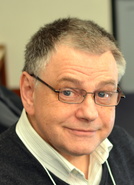MAT 220: Vector Geometry and Algebra
Stony Brook University - Spring 2017
About the course
Vectors and vector algebra. Dot product. Cross product and triple product. Complex numbers and quaternions and their geometric interpretations. symmetry, similarity transformations, affine transformations on a plane and n 3-space. Analytical geometry. Vector equations of lines and planes. Curves and surfaces of degree two. The basic notions of projective geometry. No preliminary knowledge of advanced mathematics is required.
Prerequisites
Lectures time and location
Lecturer
 Oleg Viro
Oleg ViroProfessor, Ph.D. 1974, Doctor Phys-Mat.Sci. 1983, both from Leningrad State University
Arrived at Stony Brook in 2007.
Office: Math Tower 5-110
Phone: (631) 632-8286
Email: oleg.viro AT math.stonybrook.edu
Web page: www.math.stonybrook.edu/~oleg
Research fields: Topology and Geometry,
especially low-dimensional topology
and real algebraic geometry.
Office hours
Grader
Arrived at Stony Brook in 2004
Office: Math Tower 4-122
Email: jean-francois.arbour AT stonybrook.edu
Homeworks
Exams
Final Exam: Monday, May 15, 2:15pm-5:00pm
Grading policy
Program of the course
Quaternions. Quaternion units, scalars and vectors, multiplication, conjugation, division, absolute value, unit quaternions.
Vectors and vector operations. The basic operations with vectors. Linear dependence. Bases and dimension. Arithmetic vector spaces $\mathbb R^n$. Applications to geometric problems.
Multiplications: dot and cross products. Algebraic properties and geometry of them, distance and dot product, projections to lines and planes, volume and triple product.
Analytic geometry of lines and planes. Line on a plane, their vector and coordinate equations. Various types of equations. Formulas for distances.
Transformations: isometries. Types of isometries of plane and 3-space. Their classification. Applications to geometric problems.
Similarity transformations. Classification. Relation to complex numbers.
Affine transformations. Affine invariants. Center of masses.
Polyhedra and their plane sections.
Conic sections. Ellipse, parabola, hyperbola. Equations, focal and directorial properties.
Quadratic surfaces. Cylinders, cones, ellipsoids, paraboloids, hyperboloids.
Projective spaces
Projective lines. Double ratio.
Projective geometry. Duality.